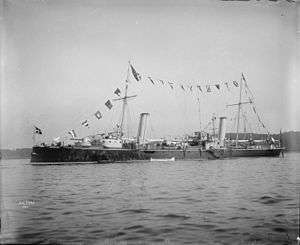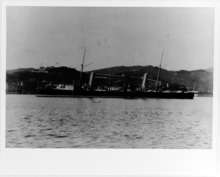Italian cruiser Aretusa
Aretusa was a torpedo cruiser of the Partenope class built for the Italian Regia Marina (Royal Navy) in the 1880s. Laid down in June 1889 at the Cantiere navale fratelli Orlando shipyard, she was launched in March 1891 and was commissioned in September 1892. Her main armament were her six torpedo tubes, which were supported by a battery of ten small-caliber guns. Aretusa spent most of her career in the main Italian fleet, where she was primarily occupied with training exercises. At the start of the Italo-Turkish War in September 1911, she was assigned to the Red Sea Squadron in Italian Eritrea. She bombarded Ottoman positions in the Arabian Peninsula and took part in a blockade of the coast. Worn out by the end of the war in October 1912, Aretusa was sold for scrap that December and broken up.
 Aretusa in 1895 | |
| History | |
|---|---|
| Name: | Aretusa |
| Namesake: | Arethusa |
| Builder: | Cantiere navale fratelli Orlando, Livorno |
| Laid down: | 1 June 1889 |
| Launched: | 14 March 1891 |
| Commissioned: | 1 September 1892 |
| Fate: | Discarded December 1912 |
| General characteristics | |
| Class and type: | Partenope-class torpedo cruiser |
| Displacement: | Normal: 833 long tons (846 t) |
| Length: | 73.1 m (239 ft 10 in) |
| Beam: | 8.22 m (27 ft) |
| Draft: | 3.48 m (11 ft 5 in) |
| Propulsion: |
|
| Speed: | 18.1 to 20.8 knots (33.5 to 38.5 km/h; 20.8 to 23.9 mph) |
| Range: | 1,800 nautical miles (3,300 km; 2,100 mi) at 10 knots (19 km/h; 12 mph) |
| Complement: | 96–121 |
| Armament: |
|
| Armor: |
|
Design
Aretusa was 73.1 meters (239 ft 10 in) long overall and had a beam of 8.22 m (27 ft) and an average draft of 3.48 m (11 ft 5 in). She displaced 833 long tons (846 t) normally. Her propulsion system consisted of a pair of horizontal triple-expansion steam engines, each driving a single screw propeller, with steam supplied by four coal-fired locomotive boilers. Specific figures for Aretusa's engine performance have not survived, but the ships of her class had top speeds of 18.1 to 20.8 knots (33.5 to 38.5 km/h; 20.8 to 23.9 mph) at 3,884 to 4,422 indicated horsepower (2,896 to 3,297 kW). The ship had a cruising radius of about 1,800 nautical miles (3,300 km; 2,100 mi) at a speed of 10 knots (19 km/h; 12 mph). She had a crew of between 96 and 121.[1]
Aretusa was armed with a main battery of one 120 mm (4.7 in) /40 gun and six 57 mm (2.2 in) /43 guns mounted singly.α She was also equipped with three 37 mm (1.5 in) /20 guns in single mounts. Her primary offensive weapon was her five 450 mm (17.7 in) torpedo tubes. The ship was protected by an armored deck that was up to 1.6 in (41 mm) thick; her conning tower was armored with the same thickness of steel plate.[1]
Service history

Aretusa was laid down at the Cantiere navale fratelli Orlando (Orlando Brothers' Shipyard) in Livorno on 1 June 1889, and was launched on 14 March 1891. After fitting-out work was completed, the ship was commissioned into the fleet on 1 September 1892.[1] During the 1893 fleet maneuvers, Aretusa served with the 3rd Division of the Reserve Squadron, along with the protected cruisers Vesuvio and Ettore Fieramosca and four torpedo boats. During the maneuvers, which lasted from 6 August to 5 September, the ships of the Reserve Squadron defended against a simulated attack by the Active Squadron, which gamed a French attack on the Italian fleet.[2]
In 1895, Aretusa was stationed in the 2nd Maritime Department, split between Taranto and Naples, along with most of the torpedo cruisers in the Italian fleet. These included her sister ships Partenope, Minerva, Euridice, Iride, Urania, and Caprera, the four Goito-class cruisers, and Tripoli.[3] As of 1898, Aretusa was assigned to the Active Squadron, with included the ironclads Sicilia and Sardegna and two other cruisers.[4]
Italo-Turkish War
At the start of the Italo-Turkish War in September 1911, Aretusa was stationed in Italian Eritrea in the Red Sea Squadron. Italian naval forces in the region also included five protected cruisers and several smaller vessels.[5] Shortly after the start of the war on 2 October, Aretusa and the gunboat Volturno encountered the Ottoman torpedo cruiser Peyk-i Şevket off Al Hudaydah. In a short engagement, the Italians vessels forced the Ottoman ship to flee into Al Hudaydah, bombarded the port facilities, and then withdrew.[6] Peyk-i Şevket was later interned in British-controlled Suez[7]
The threat of an Ottoman attack from the Arabian Peninsula led the Italian High Command to reinforce the Red Sea Squadron; the additional ships included another cruiser and several destroyers. The protected cruiser Piemonte and two destroyers annihilated a force of seven Ottoman gunboats in the Battle of Kunfuda Bay on 7 January 1912.[8] Following the neutralization of Ottoman naval forces in the region, Aretusa and the rest of the Italian ships then commenced a bombardment campaign against the Turkish ports in the Red Sea before declaring a blockade of the city of Al Hudaydah on 26 January.[8]
On 27 July and 12 August, Aretusa, her sister ship Caprera, and Piemonte conducted two bombardments of Al Hudaydah. During the second attack, they destroyed an Ottoman ammunition dump.[9] With the threat of an Ottoman attack greatly reduced, the High Command thereafter began to withdraw forces from the Red Sea Squadron. By the end of August, the unit was reduced to three protected cruisers, Aretusa, Caprera and two auxiliaries.[10] On 14 October, the Ottoman government agreed to sign a peace treaty, ending the war.[11] Aretusa's career ended shortly thereafter; the Regia Marina discarded the ship in December and she was subsequently broken up for scrap.[1]
Notes
- ^α "/40" refers to the length of the gun in terms of calibers, meaning that the length of the barrel is 40 times its internal diameter.
- Gardiner, p. 347
- Clarke & Thursfield, pp. 202–203
- Garbett 1895, p. 90
- Garbett 1898, p. 200
- Beehler, pp. 9–11
- Stephenson, p. 62
- Langensiepen & Güleryüz, p. 25
- Beehler, p. 51
- Beehler, p. 90
- Beehler, p. 93
- Beehler, p. 95
References
- Beehler, William Henry (1913). The History of the Italian-Turkish War: September 29, 1911, to October 18, 1912. Annapolis: United States Naval Institute. OCLC 1408563.
- Clarke, George S.; Thursfield, James R. (1897). The Navy and the Nation, or Naval Warfare and Imperial Defence. London: John Murray. OCLC 669157022.
- Garbett, H., ed. (1898). "Naval Notes – Italy". Journal of the Royal United Service Institution. London: J. J. Keliher. XLII: 199–204. OCLC 8007941.
- Garbett, H., ed. (1895). "Naval and Military Notes – Italy". Journal of the Royal United Service Institution. London: J. J. Keliher. XXXIX: 81–111. OCLC 8007941.
- Gardiner, Robert, ed. (1979). Conway's All the World's Fighting Ships: 1860–1905. London: Conway Maritime Press. ISBN 0-85177-133-5.
- Langensiepen, Bernd & Güleryüz, Ahmet (1995). The Ottoman Steam Navy 1828–1923. London: Conway Maritime Press. ISBN 978-0-85177-610-1.
- Stephenson, Charles (2014). A Box of Sand: The Italo-Ottoman War 1911-1912. Ticehurst: Tattered Flag Press. ISBN 9780957689220.